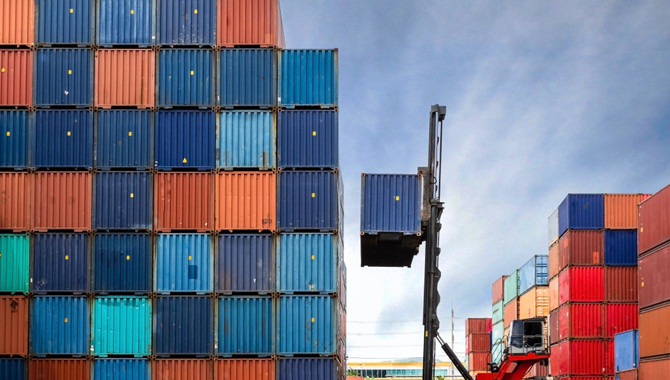Hamburg, 6th October 2022: Around 600 container logistics industry leaders attended the Digital Container Summit (DCS22), where they discussed the current state, challenges and forecast for the industry. The 4th edition of this two-day annual summit was organised by Container xChange, an online technology platform for container logistics companies to book, manage and pay for containers worldwide.
“Originally, DCS had started with 100 attendees in 2019 and today we have around 600 container logistic professionals joining this networking event. We are happy to host this event where professionals interact, network and learn about the market from each other through keynote sessions, roundtables and of course from 1:1 meetings.” said Christian Roeloffs, cofounder and CEO, Container xChange.
DCS this year was highly interactive with 124 sessions scheduled.
“This has been the USP of DCS that it is unlike any other traditional summit for our industry,” said Dr Johannes Schlingmeier, cofounder and CEO, of Container xChange.
The first industry keynote began with a session on the market outlook together with Michael King, Loadstar; Martin Dixon, Drewry, Eric Johnson, JOC.com and Peter Sand, Xeneta.
In the opening session, Martin Dixon, Head of Research Products, Drewry said, “We have downgraded our outlook for the container shipping trade for 2023 from 2.5% to 1.5%. There is a very high probability of further downgrades to this outlook.”
Dixon added, “In Europe, there is a considerable number of choices for carriers to adjust schedules at different ports while in the US, the choices are relatively limited. The cancellation rates of sailings at both Asia to Europe and Asia-North America stretch are around 20% now. So, there is already quite some disruptions around how carriers are managing capacity and we are expecting to see more of such to follow.”
Peter Sand, Chief Analyst, Xeneta added, “Far East to US West Coast freight rates are $400 starting in October 2020, still elevated by at least 100% pre-pandemic levels. Be aware that these are prone to further fall. But we see some resilience in the trans-Atlantic market. Shippers are still signing long term contracts at elevated levels, while this year has been the record-breaking year for carriers in terms of making profits.”
Eric Johnson, Director at S&P Global and Senior Technology Editor at JOC.com commented, “We’ve seen a migration of cargo from US west coast to US east coast and the uncertainty that still surrounds around the ILWU/PMA negotiations is still looming upon the trade. There is also the impact of congestion minimising from a vessel call perspective at the US West coast. Shippers have front loaded a lot of volume in the beginning of 2022 so as to avoid key shipments arriving late.”
“55-56% of volumes have been directed from US west coast to US east coast as per industry reports. The ports have done a very impressive performance for handling the cargo.” The panel discussed during the session.
Further, Andrea Monti, Sogese; Danny den Boer, SeaCube discussed the ongoing challenges and how the market is shaping up.
“Our market research indicates that the depot utilization is high and idle time of containers is increasing. The changing market conditions are preparing for another round of disruptions into the year 2023. For instance, increasing energy costs could potentially lead to difficulties for some players. The trend of decreasing freight demand too is here to stay.” summed up Andrea Monti, CEO, Sogese.
“What we now see is a reverse trend as compared to the record year 2021. The demand is falling and so are the rates. The industry witnessed a massive increase in the fleet size, and this also means that there will be a great influx of containers into the secondary market, especially the dry units.” said Danny den Boer, Director Sales & Trading, Seacube Containers.
“Shortage of equipment in China caused further delay and added to container problems. I strongly believe that ocean freight is still healthy although has started coming down. Demand for one-way containers and the pickup fees from China has already started to moderate.” said Supal Shah, CEO, Arcon Containers, India.
“Containers are stacking up at a lot of import-led ports. Shippers are giving containers away just because containers are being stuck there. Shippers will prioritize to fill up their own boxes. We are slowly getting back into a normalised economy.” said Grégoire van Strydonck, Container xChange.
Into the future: 2023 and beyond
“Factories in China have stopped production for a foreseeable future (we heard 4 months). The container depot space is full in China, Europe, India, Singapore and most part of the world. The second-hand containers will be stacked up at the depots. The supply is so high compared to demand. Prices for second-hand containers will further see a correction.” said Supal Shah.
About the outlook on containers in the near future, the panel commented, “Shipping rates are stabilizing, and this will in turn balance global trade. Many shipping lines are expecting huge ships with big fleet sizes which will further increase the demand for containers. These are some positives for the container industry.”
The opinions expressed herein are the author's and not necessarily those of The Xinde Marine News.
Please Contact Us at:
media@xindemarine.com


 Ningbo Containerized Freight Index Weekly Commentar
Ningbo Containerized Freight Index Weekly Commentar  Ningbo Containerized Freight Index Weekly Commentar
Ningbo Containerized Freight Index Weekly Commentar  Ningbo Containerized Freight Index Weekly Commentar
Ningbo Containerized Freight Index Weekly Commentar  BIMCO Shipping Number of the Week: Bulker newbuildi
BIMCO Shipping Number of the Week: Bulker newbuildi  Ningbo Containerized Freight Index Weekly Commentar
Ningbo Containerized Freight Index Weekly Commentar  Ningbo Containerized Freight Index Weekly Commentar
Ningbo Containerized Freight Index Weekly Commentar